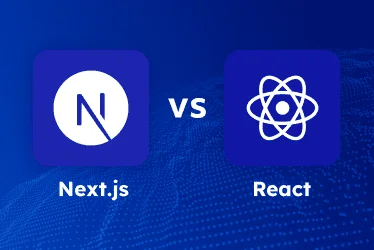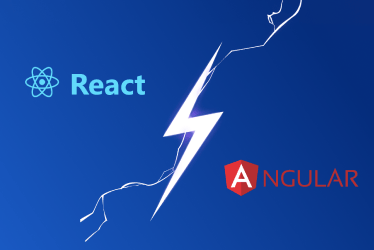ReactJS Development Company
If you’re seeking a professional ReactJS development company to build high-performing, interactive, and scalable UIs customized to your business requirements, SoftTeco is the right partner. Our ReactJS development services can help you seamlessly integrate ReactJS into your workflows or provide web solutions packed with cutting-edge features and stunning design.
17
Years on the market
450
Successful projects
300
Customers globally
500
Employees
Why Choose ReactJS For Your Project?
ReactJS is an open-source JavaScript library used for building dynamic UIs. Software engineers can create reusable and modular UI components with their component-based architecture. This approach of code reusability saves both companies’ time and costs during designing process. As for React Native, its companion framework, it uses the same ReactJS codebase to build native mobile apps for both iOS and Android platforms.
ReactJS has a vast community that provides developers with open-source libraries and tools to solve problems and create complex web apps. Maintained by Facebook, it is continuously updated for security, reliability, and compatibility. Its versatility makes it suitable for various products such as gaming, healthcare, financial, single-page applications (SPAs), CMS, social media and e-commerce platforms, etc. Due to its benefits and extensive feature set, this library is a preferred choice for modern development. See it for yourself by partnering with SoftTeco!
Our ReactJS Development Services
Consulting
SoftTeco provides ReactJS consulting, during which our specialists will analyze your existing solutions and requirements to determine how best to implement ReactJS. Our ReactJS agency will provide the most effective development strategy to meet your business objectives.
Custom Development
SoftTeco offers state-of-the-art, interactive web solutions that align perfectly with your specific business requirements and goals. Our team of experienced engineers will provide you with innovative and fully customized web applications that deliver an excellent customer experience and fulfill your business goals.
Web App Development
If you need a single-page web application (SPA), a progressive web application (PWA), or any other web solution, SoftTeco is up to the project. With a strong focus on functionality, our skilled engineers build scalable and responsive solutions with an intuitive user experience and smooth navigation.
Mobile App Development
With SoftTeco’s app development services, your mobile idea can become a reality on iOS and Android operating systems and will provide a seamless user experience. We create feature-rich, cross-platform solutions and quickly update existing functional components, ensuring high-quality results.
Plugin Development
If you would like to add new capabilities and features to enhance your existing solution, SoftTeco is always willing to assist. Our ReactJS developers use various technologies and frameworks, like React Router, Redux and Next.js, to build extremely robust and functional applications.
Architecture Building
If you need a powerful, scalable, and extensible foundation, rely on SoftTeco. With React’s component-based architecture, state management libraries such as Redux, MobX, and advanced tools, we will create a well-designed architecture based on your requirements.
Migration
If you need assistance with the loading speed and high bounce rates of your existing web solution, let SoftTeco’s migration service help you. Our developers will migrate your current solution to ReactJS to provide a more feature-rich, interactive, and secure UI with no performance impact.
Maintenance and Support
You can keep your ReactJS web app updated and running flawlessly with our post-launch maintenance and support. We perform bug fixes, security updates, compatibility upgrades, and feature enhancements in order to maintain high performance and security.
Calculate Team Cost
Get a free and instant team cost estimate in just 4 easy steps. Answer a few quick questions to see an approximate sum based on hourly rates and time required. Try it now!
Advantages of ReactJS Development
01 / 07
Component-Based Architecture
The library follows a component-based architecture, allowing developers to reuse code parts. It reduces duplication, encourages code reuse, and simplifies application support and expansion.
02 / 07
Virtual DOM and Fast Rendering
There is a built-in virtual DOM, which only updates the relevant elements of the actual DOM as needed. It improves performance and speeds up rendering, resulting in a more satisfactory user experience.
03 / 07
Exceptional Performance
With ReactJS’ virtual DOM, quick rendering, and built-in performance tools, developers can improve software performance and deliver a great user experience.
04 / 07
Seamless Integration
It is easy to integrate ReactJS with different technologies and frameworks. Hence, developers are able to gradually add elements to a project, integrating it into other projects.
05 / 07
Cost-Efficient
The library is an affordable solution due to its architecture and open-source capabilities. It promotes code reusability, decreasing the time and effort needed to build UI components from scratch. It streamlines design, reducing costs and speeding up project delivery.
06 / 07
Optimized for SEO
Engineers can build more visible and well-ranked websites by using the library, ensuring their high visibility and growing traffic.
07 / 07
Large Community and Ecosystem
Supported by Facebook and a large community of developers, ReactJS offers continuous updates, improvements, and many reliable libraries and tools available to use. It speeds up and streamlines software design.
Tech Stack That We Use in ReactJS Services
Single Page Apps
React Router
React Router DOM
Single-spa-react
Tools
Styled-components
Webpack
Module Federation
Server-side Rendering
Next.js
Remix
Gatsby
State Management
Redux Redux Toolkit
Redux-observable
Redux Thunk
Redux-Saga
Effector
MobX
Apollo GraphQL
RxJS
UI Components
Material UI
Chakra UI
Ant Design
Blueprint
Bootstrap
KendoReact
Reactstrap
React Hook Form
Formik
Data Visualization
D3JS
ThreeJS
Recharts
Nivo
Google Charts
AG Grid
Highcharts
Testing
React Test Library
Jasmine
Karma
Jest
Enzym
Spectator
Protractor
Cypress
Mocha
Puppeteer
Cross-platform
PWA
Ionic
Framework7
Hire Our ReactJS Developers
As a well-recognized ReactJS development company, SoftTeco is well-versed in top-notch web solutions. We have a diverse pool of qualified developers proficient in cutting-edge ReactJS tools and best practices. So far, we have successfully completed many projects across the globe and delivered a wide range of web products for diverse industries.
Through our skilled team of developers, you will get dynamic, highly secure, and customizable web solutions on time and according to your outlined business needs. Whether it is building custom UI components or optimizing existing projects, we guarantee high-quality outcomes.
Why Choose SoftTeco as Your ReactJS Development Company?
What our clients say
Featured Projects
FAQ
What kind of applications can you build using ReactJS?
How does ReactJS reduce development costs?
What advantages does ReactJS bring to web development?
All about React Development Service
+ Show more
Calculate Team Cost
Get a free and instant team cost estimate in just 4 easy steps. Answer a few quick questions to see an approximate sum based on hourly rates and time required. Try it now!




